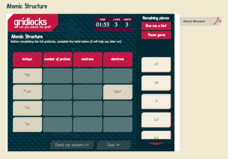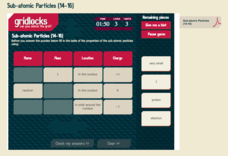Neutron Teacher Resources
Find Neutron lesson plans and worksheets
Showing 646 resources
Curated OER
All About Circuits ~ Atomic Structure
In this interactive Internet assignment, physical science investigators answer 11 questions about the atom, the subatomic particles, and atomic structure. They can click on "Reveal Answer" to discover if they are correct. They also...
Royal Society of Chemistry
Atomic Structure
Changing the number of neutrons in an atom makes it an isotope, but it does not change the element. Pupils complete logic puzzles, matching isotopes with their unique number of protons, neutrons, and electrons. Either on paper or timed...
Teach Engineering
Gumdrop Atoms
There's nothing sticky about the resource, unless you count the gumdrops! Scholars create a model of a lithium atom, complete with protons, neutrons, and electrons. It's just that these models are made with gumdrops and toothpicks.
Pearson
The Chemical Context of Life
An educational presentation includes atoms, molecules, the four major elements, as well as neutrons and protons. Additionally, slides focus on atomic number, mass number, atomic weight, polar and nonpolar covalent bonding, ionic...
DoodleScience
Atomic Structure
The Rutheford plum pudding model of an atom, as well as the nuclear model, are the subject of a video that also includes an explanation of protons, neutrons, electrons, nucleus, atomic mass, atomic charge, and ions.
Ricochet Science
Structure of an Atom
Just because we can't see an atom doesn't mean we can't study it! The video examines the makeup of the atom. It explains the roles of the protons, neutrons, and electrons.
Fuse School
Atomic Number and Mass Number
Discover the significance of the atomic number and mass number. A video lesson describes the relationship between the two numbers and the subatomic particles. The instructor leads several examples that use the two numbers to determine...
CK-12 Foundation
Atoms to Molecules: Constructing Helium
Protons and neutrons and electrons, oh my! Physical science scholars get hands-on with interactive atomic modeling. Starting with a simple helium atom, participants create and name ions, then build isotopes. Questions throughout the...
Fuse School
Why Aren't All Atomic Masses Whole Numbers?
Since an atom can't have a partial neutron, the atomic mass should always be a whole number, but it isn't! An interactive video lesson explains how the atomic mass number from the periodic table incorporates the isotopes of an element....
JFR Science
Average Atomic Mass: Why Are There Decimals on the Periodic Table?
How do you count half of a neutron? Solve the mystery of those awkward atomic masses that contain decimals with a video from JFR Science. The narrator shows viewers how to calculate the average atomic mass using the relative abundances...
Royal Society of Chemistry
Sub-Atomic Particles (14-16)
In 1897, J.J. Thomson discovered the electron, the first subatomic particle proven to exist. Scholars review their understanding of electrons, protons, and neutrons as they work through the puzzles. Each puzzle connects two or three...
Mystery of Matter
Into the Atom, Part 4: The Atom Splits
Scientific discord is part of the road to new discoveries. Scholars learn how scientists challenge each other to prove and explain their conclusions in the final lesson of the four-part series Into the Atom. The video lesson explains the...
Veritasium
Neutron Star Merger Gravitational Waves and Gamma Rays
Scientists have theorized about the merging of stars based on scientific theories and mathematical principles. For the first time, observation has confirmed these theories. Viewers share in the excitement of the discovery as they watch...
Teach Engineering
Understanding Elements
Nothing says organization quite like a table. The third lesson in a six-part Mixtures and Solutions unit teaches young scientists about elements and the periodic table. They learn how the periodic table is organized and about the...
Curated OER
Boron and Oxygen Atoms
In this atom molecule worksheet, learners will use a boron atom diagram to answer three fill-in-the-blank questions. Then students will label the protons, neutrons, and electrons on an oxygen atom diagram.
Curated OER
Element Trading Cards
In this chemistry worksheet, students use the Internet to research the elements in the Periodic Table to locate the number of proton, neutrons, and electrons. They also draw pictures that illustrate one or more uses for their elements.
Curated OER
Chemical Elements
In this elements worksheet, students determine the number of moles and the number of protons, electrons, and neutrons for given atoms or ions. Students calculate the atomic weight of an element. This worksheet has 3 fill in the blank and...
Curated OER
Sub-Atomic Particles and Energy
For this atomic particles worksheet, learners complete an elements chart comparing atomic number, mass number, protons, neutrons, and electrons. Students write the electron configuration for atoms. This worksheet has 1 graphic organizer...
Curated OER
Distinguishing Between Atoms
Every type of question is used to query young chemists about atomic structure. A vocabulary list tops the page before fill in the blanks, true/false, and matching questions are listed. This is a neatly formatted and pertinent worksheet...
Fuse School
Question - Matter Exam Question 1
How much does your class know about subatomic particles? Module 13 in a 14-part series tests their knowledge of how to determine an atom's number of protons, neutrons, and electrons when given the atomic number and the mass...
Curated OER
Atomic Structure
In this atomic structure learning exercise, students explain that an atom is made up of protons, neutrons and electrons. Then they explain that the atomic number is equal to the number of protons and the mass number is equal to the...
Curated OER
Atomic Structure
In this atomic structure worksheet, students use the periodic table to complete a chart for 11 elements/ions in terms of atomic number, number of protons, neutrons and electrons.
Curated OER
Changing an atom
In this atoms activity, students add or subtract an electron, neutron, or proton from the given atom and then fill in what kind of element it is. Students fill in 4 blanks.
Curated OER
Clay Atoms-Taming Our Fear Of The Invisible
Students create atoms with clay by using different colors to represent the protons, neutrons and nucleus. In this creative lesson students use clay to learn about atoms and see how they apply to the periodic table.
Other popular searches
- Neutron Proton Electrons
- Protons Neutrons Electrons
- Protons, Neutrons, Electrons
- Protons, Neutron, Electrons
- Protons and Neutrons
- Protons, Electrons, Neutrons
- Electrons, Neutrons, Protons
- Number of Neutrons
- Protons Neutrons, Electrons
- Isotopes Calculate Neutrons
- Proton Neutron and Electron
- Charge Free Neutrons

























